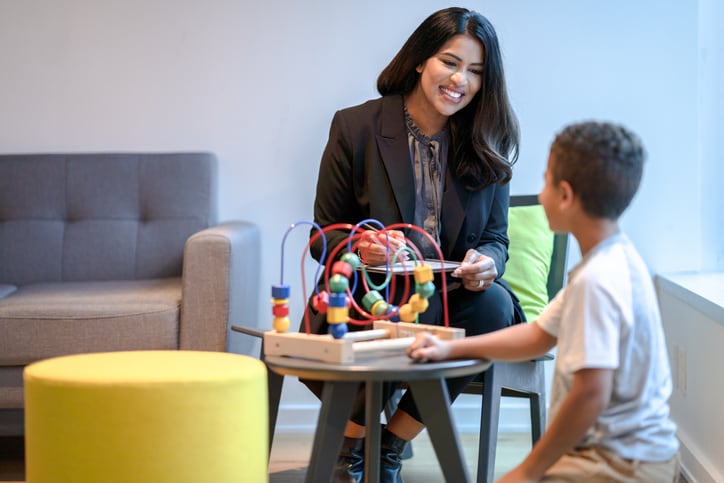Just as parents and caregivers rely on medical doctors to address issues related to their child’s physical health, they may turn to a therapist when their child is struggling mentally or emotionally. Mental health challenges can arise at any time, but are especially likely during times of transition. Going to a new school, meeting a new sibling or dealing with loss and trauma (e.g. from a death or divorce) are all typical situations that may be better managed with a therapist. And regardless of the specific troubles they’re facing, dramatic or sudden behaviour and mood changes may also be signs your child is struggling and could benefit from going into therapy.
However, presenting family or individual therapy/counselling to kids can be daunting. From fears of meeting a stranger to misconceptions about therapy and the reasons for going, a child may be resistant to seeing a therapist. But there are approaches you can lean on to help your child see therapy as a positive tool.
Here are some reasons why a child might resist therapy and ways parents can encourage them to go.
Why a child — and parent — might benefit from going into therapy
Therapy offers both parents and kids their own emotional outlet. Therapists create space between parent and child, and they are able to stay calm and present in ways that a parent can’t always achieve because of their emotional investment. This means that they can be helpful to a child in ways a parent can’t.
What’s more, talking about and recognising feelings with a view to regulating one’s emotions is a skill that one can benefit from at any age. When parents work with their own therapist, they may learn that their child’s behaviour is “normal”, relieving any feelings of guilt or self-blame they may be experiencing. A parent’s openness to seeing a therapist also shows that they are committed to their own growth and learning, which goes a long way when setting an example for a child.
Why a child might refuse therapy
A child might argue against going into therapy, regardless of age, due to worries, negative associations or misconceptions about therapy.
Some common concerns and misconceptions about therapy that parents may hear are:
- “Therapy will be boring.”
- “I won’t know what to talk about with the therapist.”
- “Therapy will be awkward, and I won’t like the therapist.”
- “If I start therapy, I’ll have to go for the rest of my life.”
To counter these myths, let kids know that it’s the therapist’s job to meet them halfway and find ways to connect. Remind them that it’s normal to feel awkward as they’re getting to know a new person, and it may take a month of weekly sessions to get more comfortable.
If a child still feels uneasy after several appointments but is willing to try someone new, it’s OK to make a switch. You can explain to your child that the goal is not necessarily to see a therapist indefinitely. The aim is to feel better and to be able to communicate openly throughout the process.
Other kids may assume that therapy is for people who are “crazy”. It’s important to address that therapy is not only for mentally ill people, whilst also tackling the stigma around mental health conditions.
Kids may also feel that they don’t need support, or they may be sceptical about the ability of therapy to help them. Put their minds at ease by highlighting that seeking therapy is not a sign of an inability to cope — it’s a tool for promoting personal growth and resilience.
They’re afraid of being judged
Judgement can be a key concern of children entering therapy. Although its benefits are widely acknowledged, it still carries social stigma and negative connotations for some. Kids may worry their peers will judge them for seeking mental health support, or that their therapist will judge them for what they express inside the therapy room.
Reassure your child that their therapist is interested in helping, not judging, and that they are free to express themselves. If they have a negative overall picture of therapy, look into real-life role models such as public figures or friends who have benefited from the process.
They’re concerned about confidentiality
Worries about embarrassment, opening up to someone new and word getting back to their parents are regular concerns for children taking their first steps towards therapy. Confidentiality is a cornerstone of the therapeutic process, except in cases of harm to oneself and others, or being harmed by someone else. Talk over the therapy agreement and the chosen therapist’s approach with your child, and address any worries they may have. A good way of reassuring your kids about their privacy is to model respectful behaviour: observe their boundaries and avoid intrusive questions after the sessions — for either the therapist or your child. It’s important for your child to understand that this is a space for them, and that they are not responsible for managing adults’ responses to their feelings.
Tips for encouraging your child to go to therapy
If you’ve listened to your child’s concerns and are finding that there is still resistance, consider offering age-appropriate encouragement. As a first step, however, you should acknowledge how they feel. A feeling of being understood goes a long way to easing a child’s worries and preparing them to take a big step. A carer doesn’t need to agree with the child or change the game plan, but it shows them that you are listening.
Taking an approach involving open communication and putting your child in the driving seat can help foster a positive attitude to therapy in children. With a skilful approach, parents can help kids see therapy as part of an everyday mental health toolbox they can use when going about their lives.
Here are age-specific ways to provide encouragement to a child who’s resisting therapy.
If your child is in primary school…
Keep it simple for children at this age and stage of life. Describing therapy as a place where they can talk about how they feel with a trusted grown-up is a useful way of conceptualising the practice for younger kids. Draw on books and other media resources that feature characters going through the therapeutic process with positive results, or tap into the aspects of play and art-making that may be involved. Explain to your child that seeing a therapist is a bit like seeing a doctor when they’re feeling ill. Acknowledge that apprehension is normal and that you, their carer, are there to support them every step of the way.
If your child is a pre-teen or in their early teens…
Children at this age are likely to fear judgement and raise the potential stigma around mental health support. It’s important to deal with this concern and to help normalise the idea of seeking out resources such as therapy and other tools for personal growth when addressing the ups and downs of adolescence. Help your child understand that the capacity to do so will help them navigate stormy waters well into the future.
All the experts we spoke to say that it’s also necessary to involve your child in choosing the type of therapy and the therapist they see. Understanding the different ways they can interact with a therapist (art, play, dance and talk) and a bit more about the person unlocks an appealing “way in” to therapy and a sense of control over the situation.
If your child is an older teenager…
Older teenagers should also be involved when choosing their therapist. Show them a potential therapist’s website or online profile and let them be part of the decision based on who seems like a good fit. Your child will feel more in control and will be more likely to engage when they begin the therapeutic relationship.
Older teens can be particularly concerned about being judged by others, and will benefit from hearing about the confidential and partly self-directed nature of therapy. They may feel better knowing they can control what they share — and that it won’t go any further. Understanding the tools therapy will give them to cope with difficult situations and accept who they are, and how these can serve them as they work to meet their long-term goals, may also offer encouragement.
Additionally, parents can help their child understand that seeking therapy is not a sign of weakness, but an approach that promotes and demonstrates resilience and independence.
What to do if your child still refuses to talk to a therapist
If you have done everything you can to convince and encourage your child to go to therapy, there is a chance they will still say no. This can be frustrating and scary for parents who feel desperate to get their child help, especially if their safety is involved.
Positive external motivations, such as mutually agreed rewards, can help incentivise attending therapy. The reward can be something like special time together or a favourite meal.
Conversations about the benefits of therapy and practices that foster good mental health can be ongoing and two-way, even if the above approaches falter and your child continues to feel sceptical. Kids might change their mind about seeing a therapist in due course, so let them know the door is always open. In the meantime, there’s also merit to meeting with a therapist without your child in order to receive support and build skills to help them.
The bottom line
Parents would do well to present therapy to their child through open, honest communication. This can involve explaining the potential benefits and outlining what to expect from the experience itself and how it can help them address any challenges or concerns they may have about going into therapy. This kind of approach can help allay a child’s fears and help them understand how therapy could help them.
One of the aims of therapy is to help an individual develop the ability to navigate their emotions and life’s challenges independently. The more your child is involved in the process, the better it will be for everyone.

